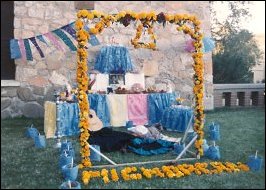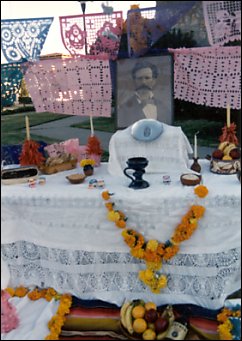

Medieval times in the Old World were a period of transition, a time when old ways slipped into disuse or went underground as Christianity rose to power. Nature-based ideologies that begat seasonal festivals with ceremonies and rituals relating to a particular geographic place are often based on the circle of life theme—life, death, and rebirth. Some scholars point out how missionaries merged Catholic celebrations with those of native tribes.
All Soul's Day was set aside by Catholics to remember the dead. But
by the time the Spanish arrived, the Aztecs had reached a view that the dead still
endured trials and challenges in the afterlife as part of their journey to peace, and
they were celebrating a feast day when the dead and living reunited. Both traditions
are now evident in the building of an ofrenda, an altar, creating a reunion or
remembrance with those who have passed. Recognizable objects, favorite foods, and
flowers balance the festival atmosphere with respect and symbolism. Some celebrate both
life and death with El Dia de Los Muertos, and the "Circle of Life"
continues.

![]()
Contributor: Florence E. Schwein, Centennial Museum, University of Texas at El Paso.
Desert Diary is a joint production of the Centennial Museum and KTEP National Public Radio at the University of Texas at El Paso.


Two ofrendas set up on the grounds of the Centennial Museum, Dia de los Muertos.
Menard, V. 2000. The Latino holiday book. Marlowe and Co., New York, 174 pp.
Milord, S. 1999. ¡Mexico! Forty activities to experience Mexico,
past and present. Williamson Publishing, Charlotte, VT, 96 pp. ![]()